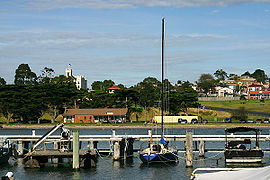Portarlington, Victoria
|
Portarlington Geelong, Victoria |
|||||||||||||
|---|---|---|---|---|---|---|---|---|---|---|---|---|---|

Portarlington seen from the town's pier
|
|||||||||||||
| Coordinates | 38°07′0″S 144°39′0″E / 38.11667°S 144.65000°ECoordinates: 38°07′0″S 144°39′0″E / 38.11667°S 144.65000°E | ||||||||||||
| Population | 3,580 (2011 census) | ||||||||||||
| Postcode(s) | 3223 | ||||||||||||
| Location | |||||||||||||
| LGA(s) | City of Greater Geelong | ||||||||||||
| State electorate(s) | Bellarine | ||||||||||||
| Federal Division(s) | Corio | ||||||||||||
|
|||||||||||||
Portarlington is a historic coastal township located on the Bellarine Peninsula, 28 km from the city of Geelong, in the state of Victoria, Australia. The gently rising hills behind the town feature vineyards and olive groves, overlooking Port Phillip Bay. Portarlington is a popular family holiday destination and a centre of fishing and aquaculture (mussels). At one time the town claimed the largest Fur Seal in the Southern Hemisphere, although the size of that beast has reduced considerably in recent decades. In the 2011 census, Portarlington (including Bellarine and the rural section of St Leonards) had a population of 3,580 people. Portarlington also has a large number of Maltese, Croatian, Italian and Islander immigrants.
The area around Portarlington was originally inhabited by the aboriginal Wathaurung people. Aboriginal shell middens can be found along the cliff-line at Portarlington. Mussels are the dominant shell species in evidence, demonstrating the importance of mussels to the area, even in pre-historic times. A ground-edged stone axe has been found at Portarlington. A stone artifact scatter also existed at a nearby site, but has been destroyed by development. Another stone artifact scatter has been identified at Point Richards, in the west of the town.
The Port Phillip area was first significantly explored by Europeans in January 1802, when Lieutenant John Murray spent three weeks investigating the Bay entrance. He does not appear to have landed at Portarlington. Ten weeks later, the English explorer, Matthew Flinders, camped at Indented Head, 6 km to the south-east of Portarlington, where he traded with aborigines while undertaking a survey of the Australian coastline. He subsequently landed several times briefly on the peninsula coast to take bearings, including at the location of Portarlington (where he shared lunch with aborigines), and also at Point Richards. In February 1803, the Surveyor-General Charles Grimes landed from his ship, the Cumberland, at Portarlington with an expedition and spent several days exploring the Bay coastline to Point Cook. They were impressed by the fine pasture and soil in the Bellarine Hills. They sailed back from Point Cook to Portarlington and landed again, where they were met by aboriginals. They traded food and utensils, however other provisions were stolen from their boat in their absence. Some evidence of smallpox among the locals was noted at that time.
...
Wikipedia

